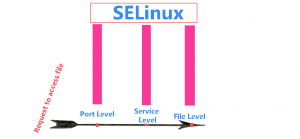SELinux Security Enhance Linux three layer protection
SELinux security feature of the Linux kernel. To manage the security enhanced Linux behavior of a system to keep it secure in case of a network service compromise.
SELinux is an additional layer of system security. It protects user data from your system services that have been compromised. Linux administrators are known with the standard user/group/other(u/g/o) permissions security model.
As a example if you see above Picture 1 Whenever outside client request for a data to access from Linux Server, SELinux will verify requested data port is allowed from SELinux, It will verify process SELinux context is enabled and File security context enabled. Three layer security system. This security will work only when SELinux is in enforcing mode.
SELinux is a set of security rules that determine which process can access which directories, files and ports. Every file, process, port and directory has a special label called a SELinux context.
SELinux label context are user, role, type and sensitivity. The type context names end with “_t“
To display or set SELinux contexts with option “Z”:
[root@server ~]# ls -lZ -rw-------. root root system_u:object_r:admin_home_t:s0 anaconda-ks.cfg drwxr-xr-x. root root unconfined_u:object_r:admin_home_t:s0 Desktop drwxr-xr-x. root root unconfined_u:object_r:admin_home_t:s0 Documents drwxr-xr-x. root root unconfined_u:object_r:admin_home_t:s0 Downloads [root@server ~]# ls -ldZ /etc/ drwxr-xr-x. root root system_u:object_r:etc_t:s0 /etc/ [root@server ~]# ls -ldZ /var/ drwxr-xr-x. root root system_u:object_r:var_t:s0 /var/ [root@server ~]# ls -ldZ / dr-xr-xr-x. root root system_u:object_r:root_t:s0 / [root@server ~]# ls -ldZ /var/log/ drwxr-xr-x. root root system_u:object_r:var_log_t:s0 /var/log/
SELinux Modes:
SELinux modes are three types :-
- Enforcing Mode
- Permissive Mode
- Disabled Mode
Enforcing Mode: Default mode which will enforce and enabled the SELinux security on your system. In this mode SELinux logs and protects.
Permissive Mode: This mode can be used to temporarily allow access to content that SELinux is restricting. No reboot required to go from enforcing to permissive vice versa. This mode is useful for troubleshooting SELinux security issues. When SELinux is in permissive mode it will not deny the access it will only log.
Disabled Mode: Completely disables SELinux your system. Your system reboot is required to disable SELinux entirely or to get disabled mode to enforcing. Until unless you reboot your machine after disable it will not effect.
For the first time when you change SELinux from disable mode to enforcing mode SELinux will relabel all the files and processes from context rules
Change SELinux modes
To check SELinux security status
[root@server ~]# sestatus SELinux status: disabled [root@server ~]# getenforce Disabled
Enable / Disable SELinux Security mode. Edit configuration file and change SELINUX=’enforcing/disabled’
[root@server ~]# vim /etc/selinux/config SELINUX=enforcing SELINUXTYPE=targeted
Enforced mode
[root@server ~]# sestatus SELinux status: enabled SELinuxfs mount: /sys/fs/selinux SELinux root directory: /etc/selinux Loaded policy name: targeted Current mode: enforcing Mode from config file: enforcing Policy MLS status: enabled Policy deny_unknown status: allowed Max kernel policy version: 28 [root@server ~]# getenforce Enforcing
To keep in permissive mode
[root@server ~]# setenforce 0 [root@server ~]# getenforce Permissive
What is the default context for newly created files / Directories
When we create an file / directory under / (slash) it will assign default_t context.
But if we create an file / directory under /etc/, /var/, /var/www/html/ it will apply different SELinux security context let see the examples below
[root@server ~]# mkdir /var/test [root@server ~]# ls -ldZ /var/test/ drwxr-xr-x. root root unconfined_u:object_r:var_t:s0 /var/test/ [root@server ~]# mkdir /etc/test [root@server ~]# ls -ldZ /etc/test drwxr-xr-x. root root unconfined_u:object_r:etc_t:s0 /etc/test [root@server ~]# mkdir /test [root@server ~]# ls -ldZ /test drwxr-xr-x. root root unconfined_u:object_r:default_t:s0 /test
How to assign SELinux Security Context
To assign a security context to file
[root@server ~]# semanage fcontext -a -t samba_share_t "/test(/.*)?" [root@server ~]# ls -ldZ /test/ drwxr-xr-x. root root unconfined_u:object_r:default_t:s0 /test/ [root@server ~]# restorecon -vRF /test/ restorecon reset /test context unconfined_u:object_r:default_t:s0->system_u:object_r:samba_share_t:s0 [root@server ~]# ls -ldZ /test/ drwxr-xr-x. root root system_u:object_r:samba_share_t:s0 /test/
To enable port
[root@server ~]# semanage port -l |grep http_port
http_port_t tcp 80, 81, 443, 488, 8008, 8009, 8443, 9000
pegasus_http_port_t tcp 5988
[root@server ~]# semanage port -a -t http_port_t -p tcp 15000
[root@server ~]# semanage port -l |grep http_port
http_port_t tcp 15000, 80, 81, 443, 488, 8008, 8009, 8443, 9000
pegasus_http_port_t tcp 5988
Too See SELinux Boolean values. Enable / Disable sebool parameters
[root@server ~]# getsebool -a |grep ftp ftp_home_dir --> off ftpd_anon_write --> off ftpd_connect_all_unreserved --> off ftpd_connect_db --> off ftpd_full_access --> off ftpd_use_cifs --> off ftpd_use_fusefs --> off ftpd_use_nfs --> off ftpd_use_passive_mode --> off httpd_can_connect_ftp --> off httpd_enable_ftp_server --> off sftpd_anon_write --> off sftpd_enable_homedirs --> off sftpd_full_access --> off sftpd_write_ssh_home --> off tftp_anon_write --> off tftp_home_dir --> off [root@server ~]# setsebool -P ftpd_anon_write on [root@server ~]# getsebool -a |grep ftpd_anon_write ftpd_anon_write --> on sftpd_anon_write --> off
Conclusion
SELinux security context is highly improved in the newer version of Linux RHEL 7 / Centos 7 / Fedora 24.
That’s it.
Please do comment your feedback on the same
Related Articles: Firewald Kerberized NFS
Book download: Download Security Intelligence
Thanks for your wonderful Support and Encouragement
- Get Email | Download E-Books
- Facebook Page
- Youtube Channel
- Exclusive Telegram Group
- Discuss On WhatsApp Group







